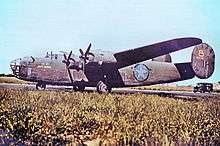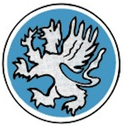2d Combat Bombardment Wing
The Second Bombardment Wing,[1] abbreviated both as 2d Bombardment Wing and 2nd Bombardment Wing,[2] of the United States Army Air Forces is a disbanded unit whose last assignment was with the Continental Air Forces, based at McChord Field, Washington. It was last active in November 1945.
| 2d Bombardment Wing | |
|---|---|
 93d Bombardment Group B-24D Liberator 41-23711, at RAF Alconbury, England, 1942 | |
| Active | 1919–21, 1922–41, 1942–45 |
| Country | |
| Branch | United States Army Air Forces |
| Role | Bomber operational command & control |
| Engagements | European Theater of World War II |
| Commanders | |
| Notable commanders | Maj Gen Oscar Westover Lt Gen Edward Timberlake Colonel James Stewart |
| Insignia | |
| 2d Bombardment Wing emblem |  |
History
Pre World War II
The wing was organized in 1919 at Langley Field, Virginia and assumed control of all Air Service units on the Atlantic Coast.[3] It was inactivated at Langley in 1921 and most of its personnel were assigned to Air Park No.3.[3] It was reactivated the following year and conducted mostly bombardment operations.[4] As the 2nd Wing, the unit became one of the original wings of the GHQ Air Force on 1 March 1935. It once again conducted much of the United States Army's pursuit, bombardment and observation operations in the eastern part of the United States. The wing's 2d Bombardment Group was the first group of the Air Corps to equip with the Boeing B-17 Flying Fortress.[1] The wing provided cadres for new tactical units activating as the Air Corps expanded under the Woodring Plan.[1] It participated in maneuvers during 1940 that influenced Air Corps doctrine on the employment of airpower.[5] The wing was inactivated in 1941 and its personnel used as the cadre for 1st Bomber Command.[6]
World War II
The group was reactivated as a heavy bomber operational command and control organization in June 1942. It moved to England, August–September 1942, and became a heavy bombardment wing of Eighth AF. In the fall of 1942, it helped to train bombardment groups assigned to Twelfth Air Force.
It served in combat in the European theater from November 1942 to June 1943. The wing ceased combat temporarily during July and August 1943 while its groups were detached to the Mediterranean theater. The wing resumed combat in the European theater in October 1943 and continued operations until April 1945. In August 1945 it returned to the US and was inactivated in November.[4]
Lineage
- Authorized on 15 August 1919 as the 2d Observation Wing[3]
- Organized on 4 September 1919
- Redesignated as 2d Wing on 14 March 1921[3]
- Inactivated on 30 September 1921.
- Activated on 8 August 1922
- Redesignated 2d Bombardment Wing on 8 May 1929[3]
- Redesignated 2d Wing on 1 March 1935
- Redesignated 2d Bombardment Wing on 19 October 1940[3]
- Inactivated on 5 September 1941
- Activated on 7 June 1942
- Redesignated 2d Combat Bombardment Wing (Heavy) 31 August 1943
- Redesignated 2d Bombardment Wing (Heavy) June 1945
- Inactivated on 7 November 1945
- Disbanded on 15 June 1983[3]
Assignments
- Eastern Department, 4 September 1919
- Third Corps Area, 20 August 1920 - 8 August 1922
- General Headquarters, 1921 – 30 September 1921[3]
- Third Corps Area, 8 August 1922
- General Headquarters Air Force, 1 March 1935
- Northeast Air District, 19 October 1940 – 5 September 1941
- I Bomber Command, 7 June 1942
- VIII Bomber Command, 7 September 1942
- 2d Bombardment Division (later 2d Air Division), 16 August 1943 – 25 August 1945
- Continental Air Forces, 6 September 1945 – 7 November 1945
- Disbanded on 15 June 1983[7]
Stations
- Langley Field, Virginia, 4 September 1919 – 30 September 1921
- Langley Field, Virginia, 8 August 1922 – 5 September 1941
- Detrick Field, Maryland, 7 June – 15 August 1942
- Old Catton (AAF-108),[8] England, c. 7 September 1942
- RAF Hethel (AAF-114),[8] England, 14 September 1943
- RAF Alconbury (AAF-102),[8] England, c. 12 June – c. 25 August 1945
- McChord Field, Washington, 6 September – 7 November 1945.
Components
Groups
|
|
Squadrons
- Base Headquarters and 1st Air Base Squadron, 1 September 1936 – 1 September 1940[3]
- 1st Squadron (Observation), 30 August 1921 – 30 September 1921[19]
- Base Headquarters and 2d Air Base Squadron, 1 September 1936 – 1 September 1940[3]
- Base Headquarters and 3d Air Base Squadron, 1 September 1936 – 1 September 1940[3]
- 3d Reconnaissance Squadron, 15 January 1941 – 5 June 1941 (attached to 13th Bombardment Group)[20]
- 19th Airship Squadron see 19th Balloon Company below
- 36th Pursuit Squadron, 2 October 1930 – 1 April 1931 (attached to 1st Pursuit Group[21]
- 37th Attack Squadron, 1 March 1935 – 31 January 1938 (attached to 8th Pursuit Group)[22]
- 55th Pursuit Squadron, 15 November 1930 – 1 April 1931 (attached to 20th Pursuit Group[21]
- 18th Reconnaissance Squadron, 1 September 1936 – ca. September 1940 (attached to 9th Bombardment Group)[23]
- 21st Reconnaissance Squadron, 1 September 1936 – ca. September 1940 (attached to 2d Bombardment Group to September 1939, 7th Naval District to 1940)[24]
- 41st Reconnaissance Squadron, 1 March 1935 – 1 September 1936 (attached to Air Corps Advanced Flying School), (attached 1 February 1940 – ca. December 1940)[25]
- 50th Squadron (Observation) (later 50th Observation Squadron), 5 August 1922 – Jun 1927 (attached to Air Service Field Officer School (later Air Service Tactical School, Air Corps Tactical School)[26]
- 88th Reconnaissance Squadron, September 1919 – 24 March 1920 (attached to 1st Army Observation Group after October 1919)[27]
Company
- 19th Balloon Company (later 19th Dirigible Company, 19th Airship Company 19th Airship Squadron), 4 September 1919 – 30 September 1921 (attached to 1st Provisional Air Brigade after 6 May 1921), 8 August 1922 – 8 May 1929 (attached 8 May 1929 – 3 November 1935)[28]
Except as noted, lineage and station information is in Maurer, Combat Units.
Awards

- European Theater of World War II
- Campaigns:
|
|
References
Notes
- Abstract of HISTORY OF SECOND WING, GENERAL HEADQUARTERS AIR FORCE, 1 Jan 1939 – 7 Dec 1941 (retrieved 29 December 2012)
- "2nd Bomb Wing – SAC – Barksdale AFB – B-47, B-52". Strategic-air-command.com. Retrieved 4 September 2016.
- Clay, p. 1243
- Maurer, Combat Units, pp. 374–375
- Abstract History I Bomber Command, Part 1, 2d Bombardment Wing, GHQ Air Force (retrieved 29 December 2012)
- Abstract, History I Bomber Command Sep 1941 – Nov 1943 (retrieved 29 December 2012)
- Department of the Air Force/MPM Letter 4989q, 15 September 1983, Subject: Disbandment of Certain Inactive Air Force Units
- Station number in Anderson
- AFHRA Factsheet, 7th Operations Group 11 May 2007 (retrieved 28 December 2012)
- AFHRA Factsheet, 1st Operations Group 1 February 2008 (retrieved 28 December 2012)
- AFHRA Factsheet, 2d Operations Group 11 February 2007 (retrieved 28 December 2012)
- AFHRA Factsheet, 8th Operations Group 11 May 2007 (retrieved 28 December 2012)
- AFHRA Factsheet, 9th Operations Group 11 May 2007 (retrieved 28 December 2012)
- Clay, p. 1308. The unit was assigned for mobilization, but was not organized while assigned to the wing.
- AFHRA Factsheet, 22d Operations Group 28 November 2007 (retrieved 28 December 2012)
- AFHRA Factsheet, 31st Operations Group 28 November 2007 (retrieved 28 December 2012)
- AFHRA Factsheet, 44th Fighter Group 1 July 2011 (retrieved 28 December 2012)
- AFHRA Factsheet, 445th Operations Group 27 December 2007 (retrieved 28 December 2012)
- Maurer, Combat Squadrons, p. 4
- Maurer, Combat Squadrons, p. 38
- Maurer, Combat Squadrons, p. 172
- Maurer, Combat Squadrons, p. 175
- Maurer, Combat Squadrons, p. 499
- Maurer, Combat Squadrons, p. 503
- Maurer, Combat Squadrons, p. 527
- Maurer, Combat Squadrons, p. 531
- Maurer, Combat Squadrons, p. 539
- Maurer, Combat Squadrons, p. 18
Bibliography
![]()
- Anderson, Capt. Barry (1985). Army Air Forces Stations: A Guide to the Stations Where U.S. Army Air Forces Personnel Served in the United Kingdom During World War II (PDF). Maxwell AFB, AL: Research Division, USAF Historical Research Center. Archived from the original (PDF) on 4 March 2016. Retrieved 7 July 2012.
- Clay, Steven E. (2011). US Army Order of Battle 1919–1941 (PDF). 3 The Services: Air Service, Engineers, and Special Troops 1919–1941. Fort Leavenworth, KS: Combat Studies Institute Press. ISBN 9780984190140. LCCN 2010022326. OCLC 637712205. Retrieved 16 October 2012.
- Maurer, Maurer, ed. (1983) [1961]. Air Force Combat Units of World War II (PDF) (reprint ed.). Washington, DC: Office of Air Force History. ISBN 0-912799-02-1. LCCN 61060979.
- Maurer, Maurer, ed. (1982) [1969]. Combat Squadrons of the Air Force, World War II (PDF) (reprint ed.). Washington, DC: Office of Air Force History. ISBN 0-405-12194-6. LCCN 70605402. OCLC 72556.
- US Army 8th Air Force in World War II, US Army Air Force Web site